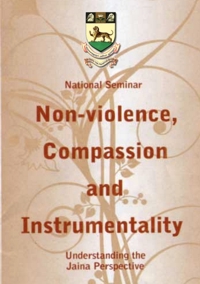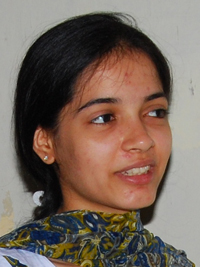Chennai 2009: Non-violence, Compassion and Instrumentality - A Jaina Perspective
 | Non-violence, Compassion and InstrumentalityA Jaina PerspectiveSeminar organized by the Department of Jainology of the University of Madras, 13 and 14 February 2009 Chennai, India |
13.02.2009
Ahiṁsā and Anekāntavāda
One of the distinctive marks of Jainism has been its long tradition of nonviolence. Living as we do in an era of unparalleled violence, this feature of the Jaina ethics should stimulate contemporary interest for finding solutions to our global problems.
Ahiṁsā is a way of living that proceeds from the recognition of the spiritual value of man as man. It is supported by the values of aparigraha and anekāntavāda that develop an outlook of non-possessiveness and non-dogmatism. Greed, hatred, attachment and intolerance give way to mind and spirit that is sensitive to life, compassionate, benevolent, and open. It is never supposed that the practice of Ahiṁsā is easy, for a person must go through many stages of purification. But once the discipline is mastered, ahiṁsā is the only way of ending all conflicts.
Violence and exclusive or one-sided viewpoint
The more intense the emotion, the more compulsive becomes false tenacity and obduracy based on one-sidedness. And false tenacity and obduracy based on one-sidedness are the main characteristics of violence. Violence is not confined to armament and war. Family quarrels, bitterness in human relations, racial, sectarian and regional conflicts, separatist thinking are forms of incipient violence which ultimately lead to armament and war. Disarmament and banning of wars are good principles, but we will have to first pay attention to the basic causes of violence. False tenacity pushes a nation into cruelty and opens the doors to violence. To reduce false tenacity anekānta provides an important alternative.
Mahāvīr Swami propounded a theory called anekāntavāda which means that reality is perceived differently from different points of view, and that no single point of view is completely true. It is the concept of reality being many-folded. Things are visible and invisible as well. We stand by visible objects and accept them as they surely are but do not recognize their invisible characteristics. Until and unless one does not recognize both these characters of an object, he cannot reach to the truth and justice.
Anekāntavāda or the Doctrine of non-one-sidedness is a negation of or is opposed to a one-sided approach. According to the non-one-sided approach while presenting one's point of view on any subject due consideration is also shown to the opposite point of view. This approach is based on the acceptance of the manifoldness of reality or in other words, acceptance of the fact that every proposition or thesis has many aspects - all of which have some element of truth from different standpoints. This concept will be clear if illustrated with an incident from Mahāvīr Swami’s life:
One day Mahāvīr was sitting in the fourth storey of his palace deeply engrossed in contemplation. His comrades came and asked mother Trishla where Vardhaman was. Busy in her household, the mother just pointed to the upper storey. The boys ran to the seventh storey, but did not find Vardhaman there. When they asked King Siddhartha, who was studying religious texts, where Vardhaman was, he just pointed to the lower storeys. Hearing the contradictory statements of the father and the mother, the boys were confused. They searched every storey and found Vardhaman in the fourth one, studying. The boys complained that they had searched all the storeys of the palace and Mahāvīr was hiding there as a philosopher. Vardhaman asked them why they did not ask the mother to tell them where he was. The boys said that the whole trouble arose out of the asking. The mother told them that he was up, while the father told them that he was downstairs. The problem was where to find and where the truth lay. Vardhaman told them that both were correct; that he was on the fourth storey, up from the point of view of the mother and down from the point of view of the father. The mother was on the first storey, while the father on the seventh. The positions downwards and upwards are relative. Without relativity there is no question of downwards or upwards. Though the nature of the substance is without any relation with any other substance, the description is relative.
From a superficial point of view the doctrine may appear too simple and obvious and thus insignificant. It may not be considered justified that so much importance has been attached to it in the philosophical sphere that it is considered a major contribution of Jainism. However, if it is remembered that much violence has resulted from intellectual differences, then any attempt towards harmony is a major step in the right direction.
Anekāntavāda is an attempt to reconcile so-called different and opposite points of view by understanding them, and as such it is rightly called a doctrine of synthesis and assimilation as well as toleration and understanding. This takes us to the philosophic source or origin of this doctrine which lies in the concept of non-violence of Jainism and which was responsible to a great extent for the development of non-one-sided approach- anekānta attitude in Jain philosophy.
The concept of non-violence with its special and significant features is a unique contribution of Jainism to the progress of human civilization. All beings want to live and live comfortably - want to have full and free experience of all their vitalities (pranas) - any attempt to infringe upon such freedom is an apparent or gross form of violence. In its fine form any reckless activity also amounts to violence, though it may or may not result in injury to living beings. The aforesaid attempts or recklessness can be in thought, word, and deed and abjuring all these is non-violence. There is also the positive side of non-violence which includes kindness and compassion, peace and pity, etc. Extension of such a non-violent attitude to the intellectual and verbal plane was natural, as one cannot be truly non-violent unless one abjures violence in thought also as much as in words and deed. Non-violence is indivisible in as much as one cannot be physically non-violent and intellectually violent, especially when it is the intellect that guides all physical activity. Therefore, the Jain concept of respect for the life of others led to the principle of respect for the views of others, which formed the basis of "anekānta" or the “non-one-sided” doctrine. This involved not only toleration of the opposite doctrines or different views but also investigation of the reasons for the difference and further attempts at reconciliation of the same.’
Humanity is tottering today upon the brink of self-annihilation due to lack of understanding, which includes understanding ourselves and understanding each other. As war begins in the minds of individuals, it is in the minds of individual that the defense of peace should be built. Today, if one person does not agree with me, he is wicked; if a country, that country is denoted as wicked as if there is no half-way, no neutrality. So ultimately it is our warring ideologies that are at the root of all our mental tension. Any solution can ultimately be achieved through knowledge free from confusion and prejudices.
Since things have many characters, they are the objects of all-sided knowledge. The knowledge which determines the full meanings of an object through the employment of one-sided knowledge is partial knowledge. Hence we should discard all absolute judgments, otherwise truth would be violated. Reality has got innumerable characteristics. A valid knowledge is defined as that which gives us knowledge of a thing in its have got innumerable characters, hence all things are multidimensional or anekāntic
We must realize that there is the other's view-point as our own. This can happen when one puts oneself into another's shoes or to get under the skin of others. This is called sympathy which is the act of reproducing in our minds the feelings of another. Gandhiji once told: "I advise a man not from my standpoint but from his. I try to put myself in his shoes. When I cannot do so, I refuse to advice." He once said: "I am myself a Puritan but for others a Catholic." It is possible for two individuals with opposite views to live together. The beauty of this world lies in the principle of let us co-exist. Therefore don't think of destroying your opponent. Define the limits and stay within them -- you within yours and he within his. Don't transgress the limits.
Every man is an independent being. So differences of ideas are but natural. If he were a machine or if he was governed mechanically, he would have thought uniformly. Since it is not the case, and since each man has a different kind of awareness, individual differences in thinking are not unnatural. However, these differences of ideas cause strife only when aggravated by emotions.
All people are not uniformly sensitive. The same thing can give the sensation of joy to one person and that of grief to another. Having these different sensations does not cause strife. The spark of strife is kindled by emotions.
There are as many temperaments and habits as there are individuals. It is the inner chemistry that is responsible for temperamental differences. But here too, these differences become a cause of strife when they are impregnated with emotions.
Conclusions
Violence is nothing but interference with life; hence it must be eschewed in thought, word and deed. Animality has been dominating our individual as well as social behavior. Hence, our life has become full of tensions, turmoil and disorders. Ignorance, false belief, a one-sided view are the main causes of subtle as well as gross violence. In the current scenario where things are changing rapidly, human thoughts also seems to change rapidly. Human beings by changing the inner attitude of their mind can change the outer aspect of life. For present day society what is awfully needed is the virtue of tolerance and understanding. In this context, Anekāntavāda (non-absolutism) is an extension of ahiṁsā in the realm of thought.
Therefore Mahāvīra says, "Kill no creature." One has to experience personally the consequences of one's own karmas (Anusamveya namappanenam, jam'ahantavvam'ti nabhipatthae). Through this unitized experience, the existence of souls is established. Mahāvīr goes on to say that one who is afflicted with lust is bereft of knowledge and perception. Truth will always baffle such a person. He indulges himself in action, causing violence to the beings of earth body, water body, fire body, vegetable body, and others. These beings have consciousness (Santi pana pudho siya).

 K. Sonal
K. Sonal
 P. Sikitha
P. Sikitha